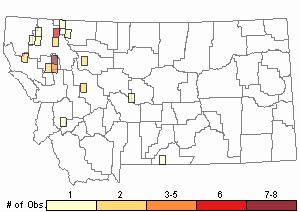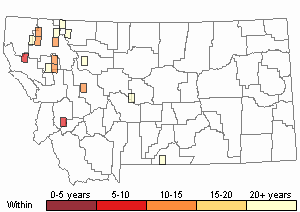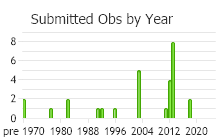View in other NatureServe Network Field Guides
NatureServe
Montana
Utah
Wyoming
Idaho
Wisconsin
British Columbia
South Carolina
Yukon
California
New York
A Marsh Moss - Calliergon giganteum
General Description
Plants: Pleurocarpous (Vitt 1988). Growing in uncrowded clumps or interwoven into mats (Lawton 1971), pink to brown or yellow (FNA 2014) or deep green distally, reddish-brown proximally. Stems 8-20 cm, frequently pinnately and abundantly branched (Lawton 1971); terminal cell of axillary hair long and quadrangular to short and very narrow; possessing a central strand and without a hyalodermis; exterior pseudoparaphyllia wide (FNA 2014).
Leaves: Stem leaves dense and overlapping near the top of the stem, loosely spaced below, spreading ca 45 degrees or more, 1.8-4 mm in length, 1.4-2 mm in width (Lawton 1971), widely heart-shaped with ovate tendencies, not pleated longitudinally (FNA 2014), slightly cupped, a little curved or twisted when dry; apex widely angled or slightly rounded; margins smooth, flat or rolled up and inward (Lawton 1971), often hood-like around the leaf tip (Crum & Anderson et al. 1981); base widely extending down the stem (FNA 2014); costa percurrent (Lawton 1971). Branch leaves egg-shaped and conspicuously more slender than the stem leaves (FNA 2014).
Leaf Cells: Alar cells long and quadrangular, swollen and fine-walled, transparent, the alar area deltoid and well-defined, extending from the leaf edges to the costa or close to it (FNA 2014); laminal cells fine-walled, occasionally porose near the bottom of the leaf; median laminal cells longer and narrower than the apical cells; apical cells adjacent to costa occasionally transparent (Lawton 1971).
Diagnostic Characteristics
The branches are typically crowded, longer near the base and becoming shorter toward the apex, with branching all around the stem and leaves more or less spreading, thereby resembling tiny Spruce trees (FNA 2014).
Calliergon cordifolium leaves are similar to the branch leaves of C. giganteum and the two species may be confused when C. giganteum plants do not develop the distinctive Spruce-like form. However, the alar region’s boundary in C. cordifolium is gradually transitioned rather than well-defined, and C. cordifolium plants are never light pink. C. cordifolium also grows in habitats higher in nutrients and slightly lower in mineral content than C. giganteum (FNA 2014).
Range Comments
North American Range
AK to NL and NS, across the northern tier of states, extending s to WY, CO, and PA (FNA 2014). Known in Montana from Carbon, Cascade, Flathead, Glacier, Lake, Lincoln, Meagher, Missoula, Sanders, Stillwater, and Teton Counties (Elliott 2016).
Observations in Montana Natural Heritage Program Database
Number of Observations: 52
(Click on the following maps and charts to see full sized version)
Map Help and Descriptions
Relative Density

Recency



 (Observations spanning multiple months or years are excluded from time charts)
(Observations spanning multiple months or years are excluded from time charts)
Habitat
Mineral-rich wetlands and shallow water (Elliott 2016), underwater, drifting on lakes (FNA 2014), emergent (Vitt 1988), lake shores. Elevation to ca 9840 feet (Lawton 1971).
Reproductive Characteristics
Dioicous (FNA 2014). Seta brown with orange tones (Crum & Anderson et al. 1981), 7-8 cm tall. Theca 3-3.5 mm in length (Lawton 1971), level to greatly inclined, long and bowed, the neck narrowing (Crum & Anderson et al. 1981); exostome with an external network of lines below and toothed above (FNA 2014); cilia of the endostome knobby (Crum & Anderson et al. 1981).
Stewardship Responsibility
References
- Literature Cited AboveLegend:
 View Online Publication
View Online Publication Crum, H.A. and L.E. Anderson. 1981. Mosses of Eastern North America. 2 volumes. Columbia University Press, New York. 1328 pp.
Crum, H.A. and L.E. Anderson. 1981. Mosses of Eastern North America. 2 volumes. Columbia University Press, New York. 1328 pp. Elliott, J.C. and A.K. Pipp. 2018. A Checklist of Montana Mosses (1880-2018). Updated 3 January, 2020. Montana Natural Heritage Program, Helena, Montana. 73 pp.
Elliott, J.C. and A.K. Pipp. 2018. A Checklist of Montana Mosses (1880-2018). Updated 3 January, 2020. Montana Natural Heritage Program, Helena, Montana. 73 pp. Flora of North America Editorial Committee, eds. 2014. Flora of North America North of Mexico. Volume 28. Bryophytes: Mosses, Part 2. Oxford University Press, Inc., NY. xxi + 702 pp.
Flora of North America Editorial Committee, eds. 2014. Flora of North America North of Mexico. Volume 28. Bryophytes: Mosses, Part 2. Oxford University Press, Inc., NY. xxi + 702 pp. Lawton, E. 1971. Moss Flora of the Pacific Northwest. Hattori Botanical Laboratory. Japan: Yamabuki-cho, Shinjuku-ku, Tokyo. 362 pages plus appendices.
Lawton, E. 1971. Moss Flora of the Pacific Northwest. Hattori Botanical Laboratory. Japan: Yamabuki-cho, Shinjuku-ku, Tokyo. 362 pages plus appendices. Vitt, D. J. Marsh, and R. Bovey. 1988. Mosses, Lichens & Ferns of Northwest North America. Seattle, WA: University of Washington Press. 296 p.
Vitt, D. J. Marsh, and R. Bovey. 1988. Mosses, Lichens & Ferns of Northwest North America. Seattle, WA: University of Washington Press. 296 p.
- Additional ReferencesLegend:
 View Online Publication
View Online Publication
Do you know of a citation we're missing? Elliot, J. C. 1993. Second checklist of Montana mosses. Unpublished report. U.S. Forest Service, Region 1. Missoula, MT. 45 pp.
Elliot, J. C. 1993. Second checklist of Montana mosses. Unpublished report. U.S. Forest Service, Region 1. Missoula, MT. 45 pp. Lawton, E. 1971. Keys for the Identification of the Mosses on the Pacific Northwest. Reprinted from 'Moss Flora of the Pacific Northwest'. Published as Supplement No. 2 of the Journal of the Hattori Botanical Laboratory. Nichinan, Miyazaki, Japan. 66 pp.
Lawton, E. 1971. Keys for the Identification of the Mosses on the Pacific Northwest. Reprinted from 'Moss Flora of the Pacific Northwest'. Published as Supplement No. 2 of the Journal of the Hattori Botanical Laboratory. Nichinan, Miyazaki, Japan. 66 pp.
- Web Search Engines for Articles on "A Marsh Moss"





